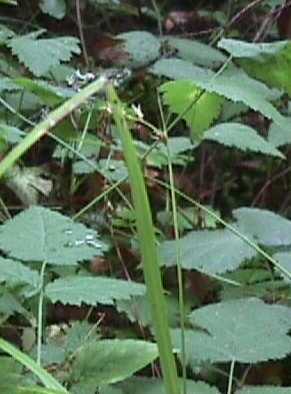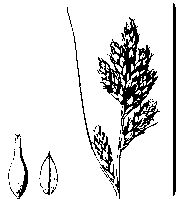


General Species Description
- The native dewey sedge may be found growing in a densely tufted manner or in looser clumps. It has short roots and weak stems that range from 20-120 cm tall. Most often, leaves are found at the bottom of the stem and do not exceed its height. Of the two to eight flower spikes per stem, a long leaf like involucral bract subtends the lowest 2.
Leaves
- The flat grass-like leaves found on the lower part of the stem are 2-5 mm in width. They are found mostly at the base of the stem. Nearest to the ground the leaves are short or reduced to sheaths at the base.
Inflorescence/Flowers
- Dewey sedge bears an inflorescence that averages from 2-6 cm in length, consisting of 2-8 spikes per stem. The spikes range from green to tan in color, are erect, and are attached directly to the stem in a loosely clustered manner. Each spike ranges from 7-20 mm in length, with the female flowers found above the male flowers. 10-25 narrow perigynia are found per spike, each 3-5 mm in length. The perigynia have thin walls, are veined, and taper at the top of the achene into a two-toothed beak out of which two stigmas grow through the top. Dewey sedge blooms late May through July.
Fruits
- Dewey sedge has a two-sided lens shaped achene which ranges from 1-2 mm in length.
Habitat
- Dewey sedge is most often found upland but also is found anywhere from low elevations up to timberline. It is often found in forest openings, moist woodlands, stream banks, and clearings. In all locations it is usually found in at least partial shade. Ferns as well as other varieties of sedges are found growing in association with Dewey sedge.
Range
- Dewey sedge is most commonly found in Washington and Oregon. It grows in virtually all counties in northwestern Oregon.
Similar Species
- A few other sedges may be confused for the dewey sedge although examination will reveal distinguishing features. Smooth sedge (Carex laeviculmis), is similar in habitat and both have weak stems although it is distinguished by its narrower leaves. Henderson sedge (Carex hendersonii) is distinguished by the presence of three stigmas rather than the two of Dewey and peri tend to be longer. Foothill sedge (Carex tumulicola) may be distinguished by its narrower leaf blades and that its spikes bear male flowers above and female flowers below.
Ecological Value
- Sedges provide forage and habitat for numerous wildlife species. The water-dispersed fruits of many species of sedges are an important food source for insects, waterbirds, finches and a few mammals. The leaves of some sedges may be used for nesting, while others that are more matted can even be used as nesting sites.
Human Value
- Indigenous peoples to America used the leaves of some species of sedge for thread as decoration. Leaves and stems are still currently being used for basketry.
References
- Pojar, J. and A. MacKinnon. 1994. Plants of the Pacific Northwest Coast. Lone Star Publishing, Richmond WA, 395 pp. Cooke, S.S., ed. 1997. A Field Guide to the Common Wetland Plants of Western Washington and Northwest Oregon. Seattle Audobon Society and Washington Native Plant Society. Seattle Audobon Society, Seattle WA, 272 pp. B.J. Guard. 1995. Wetland Plants of Oregon and Washington. Lone Star Publishing, Richmond WA, 207 pp.
This page was created by: Mindy Fagerstrom, August 1999
Return to Northwest Oregon Wetland Plants Project